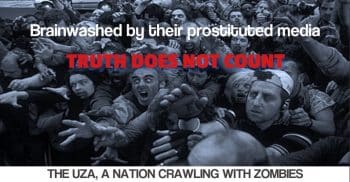REDRAWING THE ISRAELI-PALESTINE MAP
Dispatches from Deena Stryker
Thirty years later, two concepts could, I believe, break the deadlock between Israel and the people it displaced. The first is based on process dynamics. For any given act, unforeseen consequences far out-number those that were anticipated. Interactions between processes create yet more unforeseen consequences, which interact ad infinitum, as awareness of having ever-diminishing control over major events breeds resignation or irrational behavior. The Israeli government is not the only one to be affected by this process, which in broad terms is a result of exponential population growth and increasing complexity; confronted both at home and abroad with challenges they cannot meet, governments everywhere fall back upon reactive rather than creative policies, increasing the number of unforeseen consequences.
Like all processes, international law has a feedback effect; as it codifies the evolution of mentalities, it pushes them along, generating both positive and negative outcomes. Laws that were excellent forty years ago may today be counter-productive, yet even when the evidence is overwhelming, governments largely fail to question their continued validity.
Before the U.N. adopted a proposal for the partition of Palestine, in 1947, a dozen alternatives had been put forth. Since Israel accepted the UN partition and the Palestinians rejected it, territorial divisions created by conquest made the project of a Palestinian state composed of two non-contiguous areas a recipe for conflict. Meanwhile, Jews who envision Israel as a homeland for a people that endured persecution as members of a far-flung diaspora cannot accept a one-state solution that may be agreeable to many Palestinians, who would enjoy equal rights.
Even in 1988, it was clear that the new Palestinian generation was different from the old: like youth everywhere, it moved through time more rapidly. An organization that was then still in its infancy is in power in Gaza, and Arafat’s successors are challenged by their constituents in the West Bank as well as by Hamas. In Israel, war fatigue and resignation have brought to power a far-right determined to avoid any of the solutions that would have the imprimatur of the world community.
The often arbitrary delineation of boundaries. and the Fourth Geneva Convention, drawn up after World War II, aimed at protecting populations from arbitrary relocation, has functioned as the universal law on displaced persons, forcing groups whose national or religious conflicts have deep historical roots to live side by side in on-going violence. Numerous dramatic precedents justified the 1951 Geneva Refugee Convention, but those forced population movements took place in a very different world from that of today, and in fact it specifically does not apply to Palestinian refugees.
In the twenty-first century states have the physical means to remove populations with minimum suffering from co-habitations that condemn them to daily strife. Where necessary, UN organized population exchanges can be coupled with an appeal to the two communities’ diasporas, for financial support destined to insure that newly settled populations – both Jewish and Arab – are provided with maximum technical, agricultural and investment support. If high-tech development and ample financial means have allowed the Israelis to reclaim the desert, the same could apply to Palestinians, on condition they benefit from comparable funding.
Israel’s main objections to a Palestinian West Bank state are based on security concerns (although it views its most serious threat as coming from Iran, a thousand miles away), causing it to demand a military presence between it and its neighbor, Jordan. By sacrificing a part of the Negev, the only point at which Israel would be “perilously” narrow would be east of Jerusalem, and the entire state would be one bloc, as would the Palestinian state, as shown in the rough map.
[dropcap]S[/dropcap]ince 1947, Israel has located much of its high-tech industry and military installations in the Negev Desert. It has also relocated about 250,000 settlers to the area to counterbalance the presence of a slightly lower number of Bedouins, most of whom have resisted efforts at ‘sedentarization’ continuing to live in “unrecognized Bedouin villages”.
The creation of a Palestinian state in the West Bank and Gaza would require the same kinds of special roads which already make daily life a travesty in the West Bank. And even were a significant number of Jewish settlers to be relocated, the land comprising that part of a Palestinian state would remain highly fragmented. If two compact states were created, fewer numbers of Jewish settlers would have to be relocated, while by leaving their historical homes in the West Bank, Palestinians would gain a contiguous state.
This plan leaves the issue of Jerusalem unresolved, and it will not be broken if the outcome advantages either side. The biggest symbolic impediment to peace can only be solved by a creating a new symbolism. Both parties claim the city as their capital because of its historical symbolic importance: for the Jews, it is the site of the first Temple (?); while for Muslims it is the site of the Prophet’s ascension to heaven. While these are separate cultural symbols, both peoples share a more fundamental symbol in the city’s name. Jerusalem means peace, as in the Hebrew greeting “Shalom” and the Arab “As Salamu Alekum”, and this shared symbol suggests a solution for the issue of sovereignty. By agreeing to make Jerusalem the capital of a new U.N. Peace and Conflict Resolution Council in order to further peace in other areas of the world. Israelis and Palestinians could renounce their respective claims without giving the advantage to the other side. An internationally recognized ‘sacrifice’ would raise the status of both peoples, enabling each of them to accept another city as capital without losing face, for example Tel Aviv and Ramallah.
As the headquarters of a pivotal U.N. body, Jerusalem would incarnate the renunciation of the two peoples who have fought the longest, to aid other peoples involved in territorial disputes. Jews and Palestinians would live freely in and jointly administer Jerusalem together with the UN. Itzak Rabin said: It’s always with an enemy that one makes peace,” and in this spirit, Jerusalem would at last fulfill the destiny implied in its name, becoming a site for pilgrimages both religious and political.
In addition to The Peace and Conflict Council, other entities would generate economic stimulus for the development of Palestine and Israel’s other neighbors:
1) A U.N. University War and Conflict Resolution Studies Programs
- UNESCO Peace Education Programs
- U.N. population transfer implementation programs
- U.N. Peacekeeping Force
- NGO’s involved in monitoring peaceful coexistence once territorial issues are resolved.
The Bible and 20th century international law are not interchangeable. Today’s Palestinians must not be held responsible for their fathers’ – or other Arabs’ – mistakes, anymore than today’s Germans are held responsible for the Holocaust. Unreserved acceptance of Israel by its Arab neighbors, like that of any inhabitant returning after a long absence, rests not only on its refusing to be intimidated, but on having something to offer the community it seeks to reintegrate. Israel’s technological achievements put it far ahead of its neighbors. For it to become the Jewish homeland it was intended to be, the answer may be that it should share its expertise with its neighbors.
DEENA STRYKER, Associate Editor
 Born in Philadelphia, Stryker spent most of her adolescent and adult years in Europe, resulting over time in several unique books, her latest being
Born in Philadelphia, Stryker spent most of her adolescent and adult years in Europe, resulting over time in several unique books, her latest being
CUBA: Diary of a Revolution, Inside the Cuban Revolution with Fidel, Raul, Che, and Celia Sanchez
America Revealed to a Honey-Colored World
A Taoist Politics: The Case For Sacredness
She began her journalistic career at the French News Agency in Rome, spent two years in Cuba finding out whether the Barbados were Communists before they made the revolution (‘Cuba 1964: When the Revolution was Young’). After spending half a decade in Eastern Europe, and a decade in the U.S., studying Global Survival and writing speeches in the Carter State Department, she wrote the only book that foresaw the fall of the Berlin Wall AND the dissolution of the Soviet Union (“Une autre Europe, un autre Monde’). Her memoir, ‘Lunch with Fellini, Dinner with Fidel’, tells it all. ‘A Taoist Politics: The Case for Sacredness’, which examines the similarities between ancient wisdom and modern science and what this implies for political activism; and ‘America Revealed to a Honey-Colored World” is a pamphlet about how the U.S. came down from the City on a Hill’.
MAIN IMAGE: IDF soldiers deployed in Nablus during Second Intifada.
Note to Commenters
Due to severe hacking attacks in the recent past that brought our site down for up to 11 days with considerable loss of circulation, we exercise extreme caution in the comments we publish, as the comment box has been one of the main arteries to inject malicious code. Because of that comments may not appear immediately, but rest assured that if you are a legitimate commenter your opinion will be published within 24 hours. If your comment fails to appear, and you wish to reach us directly, send us a mail at: editor@greanvillepost.com
We apologize for this inconvenience.
 What will it take to bring America to live according to its own propaganda?
What will it take to bring America to live according to its own propaganda?
=SUBSCRIBE TODAY! NOTHING TO LOSE, EVERYTHING TO GAIN.=
free • safe • invaluable
Please see our red registration box at the bottom of this page
REMEMBER: ALL CAPTIONS AND PULL-QUOTES BY THE EDITORS, NOT THE AUTHORS.
For media inquiries contact us at greanville@gmail.com

